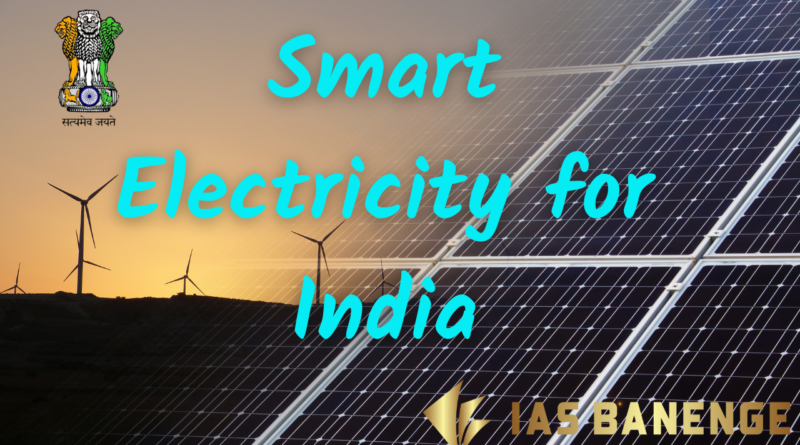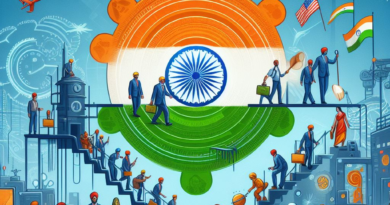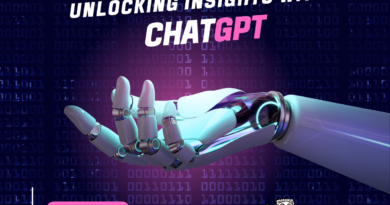Smart Electricity for India | Ias Banenge
Context
- The power sector in India is undergoing a significant shift towards smart metering interventions to provide smart electricity.
- By 2025–2026, the nation hopes to have installed more than 5.5 million prepaid smart metres in place of 250 million conventional electric metres.
- The Ministry of Power is spearheading a national campaign to inform consumers about the advantages of smart metres, and discoms are required to co-own and assume control of the initiative.
- To assist power distribution companies (discoms) become financially stable and effective so they can provide better services to consumers, India is supporting this initiative through a results-linked grant-cum-financing.
Relevance:
GS Paper-2: Government Policies and Interventions for Development in various sectors and Issues arising out of their Design and Implementation.
READ MORE – India’s Delayed Implementation of Mandatory Drug Recall Law-Ias Banenge
Mains Question
Describe the advantages and difficulties of India’s smart metering initiative. What actions can the government, power distribution companies, and technology providers take to address these issues and make the initiative successful?
Benefits of technology:
- According to a recent study by the Council on Energy, Environment and Water (CEEW), most users of smart metres have already started to take advantage of some technology advantages.
- About 2,700 urban households in six States using prepaid or post-paid smart metres were included in the study.
- Two-thirds of users said paying bills had gotten easier, and half of users said billing regularity had improved.
- About 40% of users mentioned a variety of side benefits, including better local power supplies, a feeling of control over their electricity costs, and a decline in electricity theft.
- In fact, 70% of people who use prepaid smart metres said they would advise others to use the technology.
- These results provide assurance that India’s transition to smart metres is going in the right direction.
Implementation difficulties:
• Despite the advantages, there are still some hiccups. Due to the fact that many users were unable to access detailed electricity bills and that 50% of users were not using the smart metre mobile app, they had doubts about how their bills were calculated and what deductions had been made. To bring about a smart metre revolution in India, these problems must be resolved.
Solutions for a Future of Smart Electricity:
- India must adopt a user-centric design and deployment strategy as it works to realise its vision of a financially stable and digitalized power sector through smart metering interventions.
- Here are four ideas for diverse actors who want to step up.
- Lead National Education Campaigns: The Ministry of Power should spearhead a national campaign to inform consumers about the advantages of smart metres and boost the adoption of smart metre apps.
- The apps should be usable by users from various socioeconomic backgrounds and offer information and advice that can be put into practise.
- This is significant because user satisfaction with smart metres is related to users’ perceptions of the benefits of technology and their ability to access and understand online bills.
- High user satisfaction in Assam and high mobile app adoption in Bihar point to opportunities for learning how to scale the use of smart metres for discoms in other States.
- Co-Own the Programme: Discoms must share ownership of the programme and assume control.
- The Advanced Metering Infrastructure Service Providers (AMISPs), who are in charge of setting up and running the AMI system for the duration of the project (10 years), are deploying the majority of smart metres in India.
- In order to use smart metre data for revenue protection and consumer engagement, Discoms must closely collaborate with AMISPs to guarantee a seamless installation and recharge experience for users.
- To achieve this, discoms must strengthen their internal capability through appropriate staffing and training measures.
- Work Together to Develop Creative and Scalable Data Solutions: Discoms, System Integrators, and Technology Providers should all work together to develop creative and scalable data solutions.
- Making the most of smart metre data is essential to revealing their true value.
- This would necessitate the creation of an ecosystem that encourages innovation in analytics, data hosting, and sharing platforms and allows for the cooperative testing and scaling of novel solutions by key actors.
- Strengthen Regulations: To give consumers the power to open up new retail markets, policymakers and regulators must strengthen regulations.
- At the moment, crucial clauses relating to the gradual phase-out of paper bills, arrear adjustment, frequency of recharge alerts, buffer time, rebates, and data privacy are dispersed throughout various regulatory orders or are simply absent.
- Their integration into already-existing State frameworks will be essential for ensuring that end users have a positive technological experience.
- The retail market must be made open to new business models and prosumers (producers, consumers, and storage users). Regulators must also permit innovation and simplification in tariff design.
- The Ministry of Power took a progressive step last month when it proposed changes to the Electricity Rules that would allow time-variable tariffs for all users of smart metres.
Conclusion:
Smart metres are an essential component of the transition toolbox because they promote responsible consumption, effective energy management, and the cost-effective integration of distributed energy resources. The success of India’s smart metering initiative will depend on its adoption of a user-centric design and deployment philosophy.





Pingback: India’s Strategic Nuclear Gamble Worked-Ias Banenge